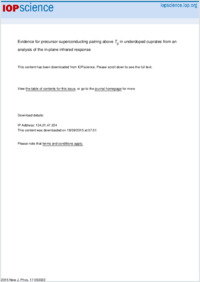Evidence for precursor superconducting pairing above T c in underdoped cuprates from an analysis of the in-plane infrared response
- Šopík, B. Central European Institute of Technology, Masaryk University, Brno, Czech Republic
- Chaloupka, Jiří Central European Institute of Technology, Masaryk University, Brno, Czech Republic
- Dubroka, Adam Central European Institute of Technology, Masaryk University, Brno, Czech Republic - Department of Condensed Matter Physics, Faculty of Science, Masaryk University, Brno, Czech Republic
- Bernhard, Christian University of Fribourg, Department of Physics and Fribourg Centre for Nanomaterials, Fribourg, Switzerland
- Munzar, Dominik Central European Institute of Technology, Masaryk University, Brno, Czech Republic - Department of Condensed Matter Physics, Faculty of Science, Masaryk University, Brno, Czech Republic
-
15.05.2015
Published in:
- New Journal of Physics. - 2015, vol. 17, no. 5, p. 053022
English
We performed calculations of the in-plane infrared response of underdoped cuprate superconductors to clarify the origin of a characteristic dip feature which occurs in the published experimental spectra of the real part of the in-plane conductivity below an onset temperature ${{T}^{{\rm ons}}}$ considerably higher than ${{T}_{{\rm c}}}$. We provide several arguments, based on a detailed comparison of our results with the published experimental data, confirming that the dip feature and the related features of the memory function $M(\omega )={{M}_{1}}(\omega )+{\rm i}{{M}_{2}}(\omega )$ (a peak in M1 and a kink in M2) are due to superconducting pairing correlations that develop below ${{T}^{{\rm ons}}}$. In particular, we show that (i) the dip feature, the peak and the kink of the low-temperature experimental data can be almost quantitatively reproduced by calculations based on a model of a d-wave superconductor. The formation of the dip feature in the experimental data below ${{T}^{{\rm ons}}}$ is shown to be analogous to the one occurring in the model spetra below ${{T}_{{\rm c}}}$. (ii) Calculations based on simple models, for which the dip in the temperature range from ${{T}_{{\rm c}}}$ to ${{T}^{{\rm ons}}}$ is unrelated to superconducting pairing, predict a shift of the onset of the dip at the high-energy side upon entering the superconducting state, that is not observed in the experimental data; (iii) the conductivity data in conjunction with the recent photoemission data (Reber et al 2012 Nat. Phys. 8 606, Reber et al 2013 Phys. Rev. B 87 060506) imply the persistence of the coherence factor characteristic of superconducting pairing correlations in a range of temperatures above ${{T}_{{\rm c}}}$.
- Faculty
- Faculté des sciences et de médecine
- Department
- Département de Physique
- Language
-
- English
- Classification
- Physics
- License
- License undefined
- Identifiers
-
- RERO DOC 257330
- DOI 10.1088/1367-2630/17/5/053022
- Persistent URL
- https://folia.unifr.ch/unifr/documents/304617
Statistics
Document views: 73
File downloads:
- ber_eps.pdf: 82
